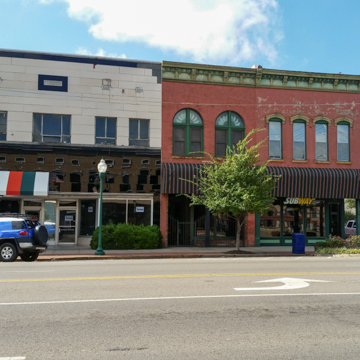Garrison Avenue may have been laid out by John Rogers (see SB4), an early settler and trader. The street is unusually wide because it is said to have been used as a parade ground for soldiers. Garrison Avenue’s buildings are a mix of heights from two-story Italianate and Romanesque Revival commercial structures to multistory twentieth-century office and hotel buildings. Like many historic downtown commercial boulevards, it has lost some of its original vitality and luster and has experienced some abandonment. Nevertheless, at the corner of Garrison and 6th Street are three high-rise buildings that demonstrate the city’s twentieth-century economy and range of styles. At 521–523 Garrison, the eleven-story former Ward Hotel (1929), which features a limestone base, brick walls, and details that include sculptural swags above the windows, is being converted into apartments and commercial space. The First National Bank of Fort Smith occupies the eight-story early-twentieth-century structure at 602 Garrison. It has elaborate terra-cotta ornamentation along the top story and finishes with a prominent modillioned cornice. Completely different is the First Federal Savings and Loan (c. 1960) at 542 Garrison. This asymmetrical midcentury modern composition of six stories, with a partially open seventh-story terrace covered by the flat roof, has a plain tower-like corner carrying a vertical sign of stacked box-like shapes. The building has smooth curtain walls of aluminum and aqua-colored spandrels.
You are here
Commercial Buildings on Garrison Avenue
If SAH Archipedia has been useful to you, please consider supporting it.
SAH Archipedia tells the story of the United States through its buildings, landscapes, and cities. This freely available resource empowers the public with authoritative knowledge that deepens their understanding and appreciation of the built environment. But the Society of Architectural Historians, which created SAH Archipedia with University of Virginia Press, needs your support to maintain the high-caliber research, writing, photography, cartography, editing, design, and programming that make SAH Archipedia a trusted online resource available to all who value the history of place, heritage tourism, and learning.





















